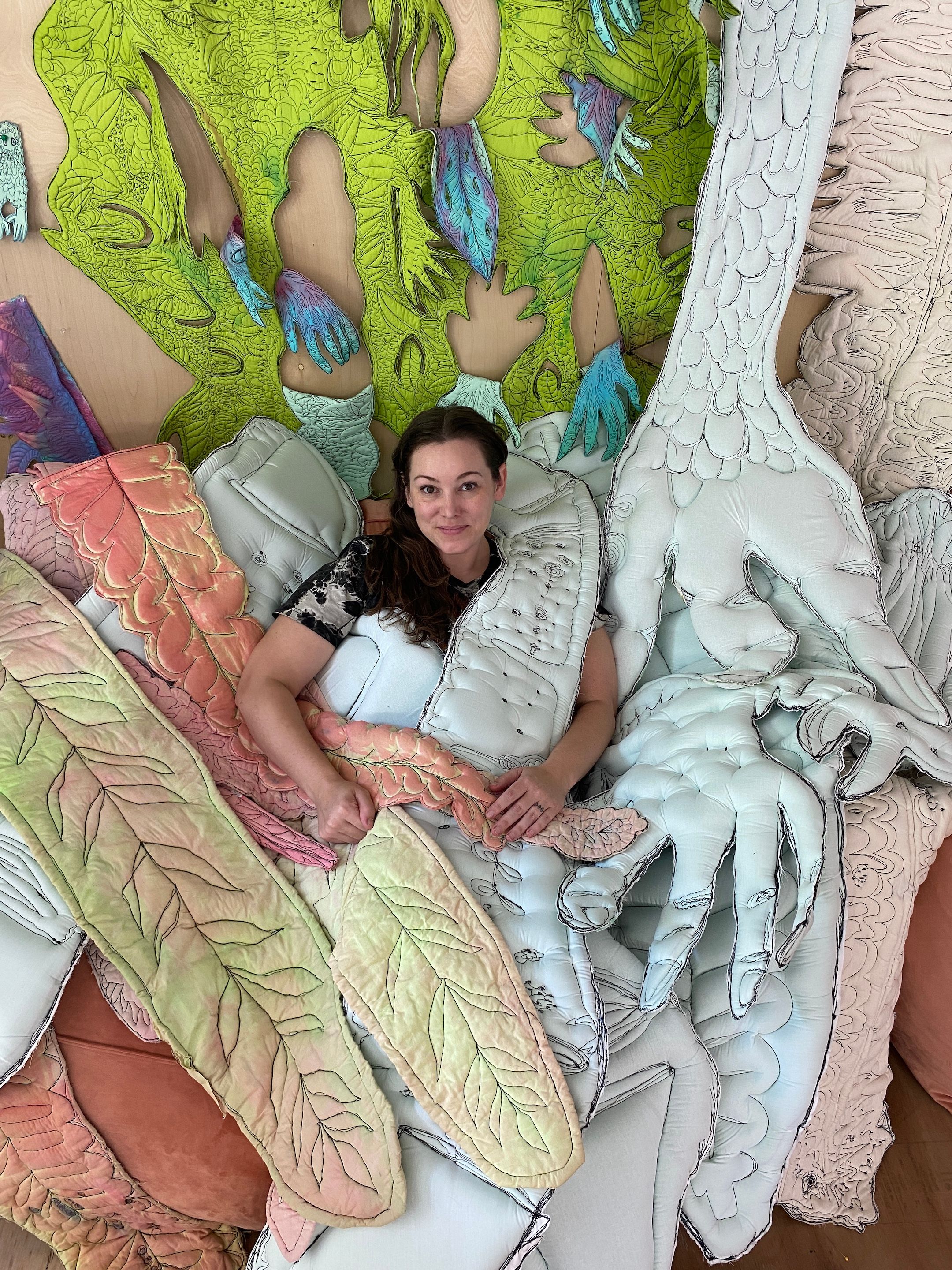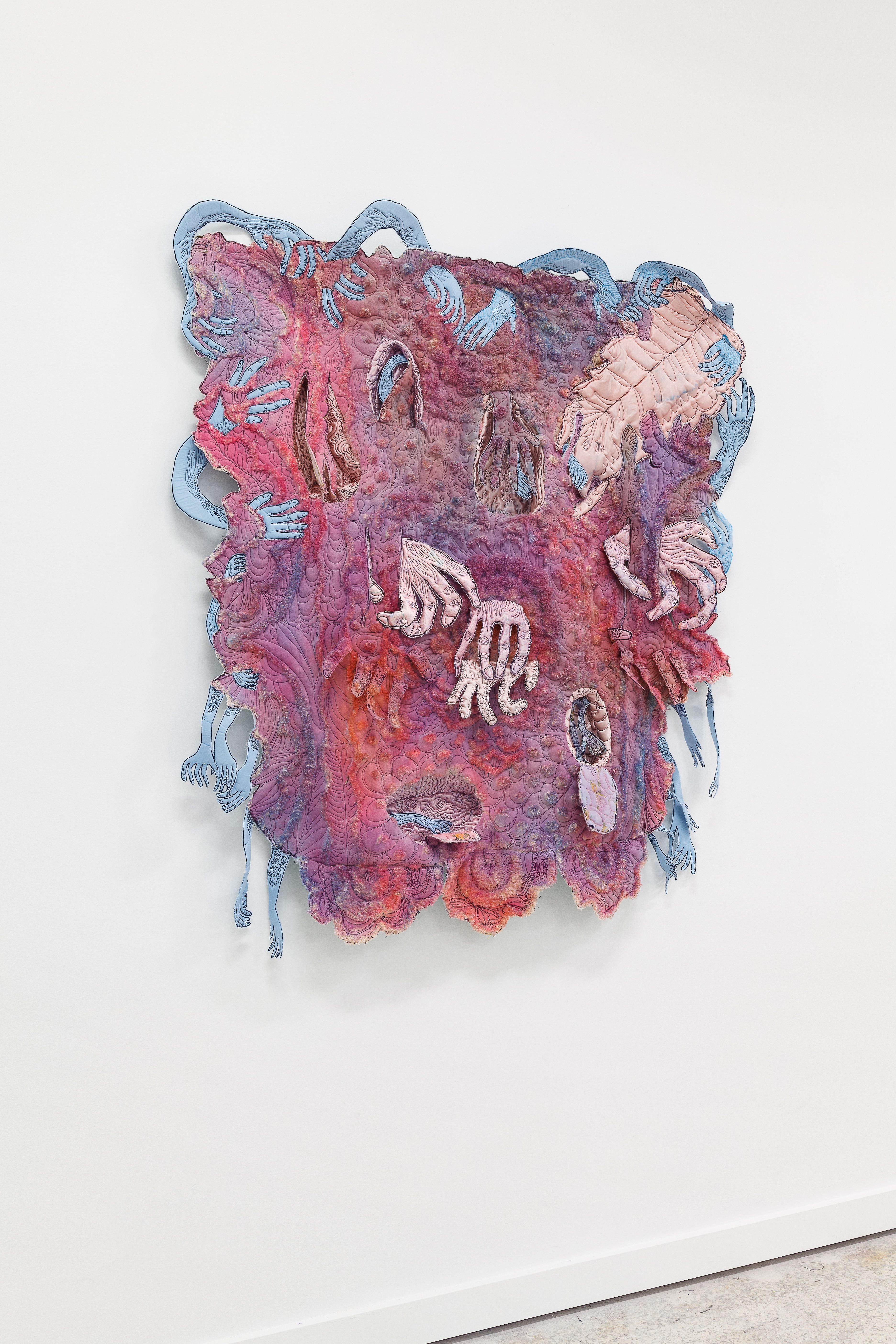
For the past decade, Jen Clay has explored dreams, human connections, and a real and imaginary life in her multimedia, polymorphic practice. She has produced an experimental body of work in which she has deftly embraced techniques as varied as quilting, sculpture, animation, installations, and video games.
In Jen’s universe, quilted textiles combine naturally with animation in video games where a hallucinogenic perception of reality is both playful and infused with a sense of unease. Jen’s is a world of “friendly aesthetics” that fluctuates between humor and melancholy.Her vibrantly colorful creatures, wall-mounted, animated, or suspended from the ceiling, are often made in disconcerting shapes, yet invite the viewer to connect.
The North Carolina native received a Masters in Fine Arts in sculpture while also studying costume design and behavior analysis at the University of Florida. Today, Jen is based in South Florida, where she lives with her husband and daughter.
Miami-based writer Nazanin Lankarani sat down with the artist to learn more about her work and discuss her exhibition Eyes of the Skin at Locust Projects, a non-profit, alternative art space in Miami, and her presentation with Miami art gallery Emerson Dorsch at this year’s fair.
Nazanin: What is your background?
Jen: I grew up in the foothills of the North Carolina mountains, a place so remote it had no public transportation.My dream was to move to a town with sidewalks where I could walk my dog on a leash, and there would be people around. My grandparents had a cattle farm, and my mother made furniture. We lived not far from Hickory, “the furniture capital of the world,” and many people there worked in the upholstering and furniture business.I left home to break the cycle of working in furniture.
Nazanin: How did you evolve as an artist after school?
Jen: I work full time now as an artist. When I first started out, I was hungry as an artist and would come up with a lot of ideas for performances or experiences just to push my work. From the start, my goal was to offer people an interaction with something supernatural, like in projected animation, where costumed characters would interact with you.


Nazanin: Why this interest in the super-natural?
Jen: In the rural town where I grew up, if you heard a noise at night in the woods, people would say it was supernatural. There were many stories about aliens and ghosts in my family, in part because everyone was uncomfortable talking about mental health. It came as a relief when my mom was diagnosed as bipolar. I have also been diagnosed with a form of mental illness. In my work, I try to show what it is like to have mental health issues, to feel an “alien-ness” inside of you.
I like to talking about it as a way of normalizing it. I can show what it’s like to have more thoughts that are different. Some of my creatures and costumes are the manifestation of my own depression and anxiety. They take away my shame, and make things less scary because they are also kind of fun.
Nazanin: Still, your aesthetics are playful and positive?
Jen: I call it a “friendly aesthetics” that is made possible because I use textiles and quilting. I love to make pieces that people are comfortable touching. I wanted people to feel how soothing a piece can be. Personally, I love sitting and cuddling, and in my work, I also want people to sit in my work and touch the pieces. That is why I also make furniture and artist books that you are allowed to touch.
Nazanin: Are your furniture pieces related to your family background?
Jen: I am definitely influenced by my family’s background in furniture and upholstering. I use a foam that has a tactile quality and is used to make comfortable seating. I always try to create a snuggly and safe environment. The furniture invites you to sit and in a way to become involved in the work. My big armchairs, for instance, are made like bean bags. They have quilted leaves sewn on them, and they invite people to touch them.

Nazanin: How central is textile to your practice?
Jen: I am very partial to textile. They make me grounded in reality. Wearing clothes is an intimate thing, and it involves textiles. My great-grandmother used scraps of hard upholstery fabric to make quilts, but she had to work those scraps to make them softer. When I am nervous, I tend to pet things. So with textiles, I am tapping into what makes us comfortable. A piece may look spooky, but because it is made from textiles, it is still welcoming.
Nazanin: What known artist do you admire most?
Jen: I love Louise Bourgeois, and her pink pieces that are soft and sonvey a sense of fragility. She moved easily from one medium to another. She once said that art helped to get through the day. That is also my compulsion.
Nazanin: How did you combine quilting with video?
Jen: I have made the world’s first interactive video game made of entirely of quilts. The video involves different universes that open up as you activate the game. You go through the forest, and characters try to interact with you against 12 different backgrounds. Obviously you cannot touch things in the video, but you know that the whole thing feels very soft. My goal was to express a literal softness when navigating through the video.


Nazanin: Your forest seems to open up like in a child’s dream, or is it a nightmare?
Jen: The imagined alien forest represents the journey of “getting out of the woods.”I have heard the word “child-like” used about my work, but I see it more as having a friendly and welcoming quality, with forms and figures that are not categorizable.You might see a hand, a root, a tree or a limb, but these are shapes are not exact; in fact they are more like doodling.
Nazanin: What do you plan to show at the Untitled Art?
Jen: My gallery Emerson Dorsch will be showing quilts and a few paper pieces. The quilts are a tree-like creatures with flaps that you can lift to read a message.Some pieces are made with fabric in muted colors because during Covid when I started the quilting series, people were buying a lot of fabric and I used mainly leftover colors. Then I started dying the fabric myself and also incorporating found fabrics. Now, my pieces are much more colorful.
Nazanin: What direction will you take in the future?
Jen: Art lets me be brave. I don’t have the same opportunity in other aspects of my life. But with art, I know I am going to get it done by any means necessary. Trying and being brave are the most exciting part of my work. I always seek the intimacy of a one-on-one personal experience with people, which is why I want people to interact with my pieces. As far as technique, I want to keep quilting, and making more quilt series. I hope this will be the core of my practice.
Nazanin Lankarani is a consultant, lawyer and independent journalist specialized in the art world and luxury industries. She is a regular contributor to the International New York Times and Vanity Fair. She also serves as mediator on expert panels, and is a co-author of Delicious Jewels, a book on the jewelry house of Hemmerle.